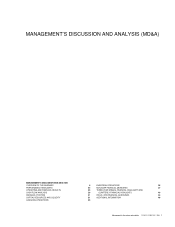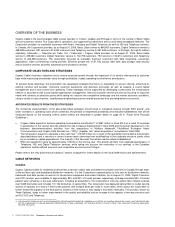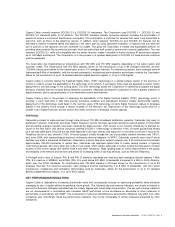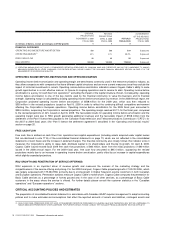Cogeco 2009 Annual Report Download - page 17
Download and view the complete annual report
Please find page 17 of the 2009 Cogeco annual report below. You can navigate through the pages in the report by either clicking on the pages listed below, or by using the keyword search tool below to find specific information within the annual report.16 COGECO CABLE INC. 2009 Management’s discussion and analysis
BUSINESS COMBINATIONS, CONSOLIDATED FINANCIAL STATEMENTS AND NON-CONTROLLING INTERESTS
In January 2009, the CICA issued Handbook Section 1582, Business Combinations, which replaces Section 1581 of the same
name, and Sections 1601, Consolidated Financial Statements and 1602, Non-Controlling Interests, which together replace Section
1600, Consolidated Financial Statements. These new Sections harmonize significant aspects of Canadian accounting standards
with the International Financial Reporting Standards (“IFRS”) that will be mandated for entities with fiscal years beginning on or after
January 1, 2011.
Section 1582 requires that all business acquisitions be measured at the fair value of the acquired entity at the acquisition date even
if the business combination is achieved in stages, or if less than 100% of the equity interest in the acquiree is owned at the
acquisition date, and expands the definition of a business subject to an acquisition. The Section also establishes new guidance on
the measurement of consideration given and the recognition and measurement of assets acquired and liabilities assumed in a
business combination. Furthermore, under this new guidance, acquisition costs, which were previously included as a component of
the consideration given, and any negative goodwill resulting from the allocation of the purchase price, which was allocated as a
reduction of non-current assets acquired under the previous standard, will be recorded in earnings in the current period. This new
Section will be applied prospectively and will only impact the Corporation’s consolidated financial statements for future acquisitions
concluded in periods subsequent to the date of adoption.
Sections 1601 and 1602 dealing with consolidated financial statements require an entity to measure non-controlling interest upon
acquisition either at fair value or at the non-controlling interest's proportionate share of the acquiree's identifiable net assets. The
new Sections also require non-controlling interest to be presented as a separate component of shareholders' equity.
The new standards will apply as of the beginning of the first annual reporting period beginning on or after January 1, 2011, with
simultaneous early adoption permitted. Early adoption may reduce the amount of restatement required upon conversion to IFRS.
The Corporation is currently assessing the impact of these new Sections on its consolidated financial statements.
HARMONIZATION OF CANADIAN AND INTERNATIONAL ACCOUNTING STANDARDS
In March 2006, the Accounting Standards Board of the CICA released its new strategic plan, which proposed to abandon Canadian
GAAP and effect a complete convergence to the IFRS for publicly accountable entities.
In April 2008, the CICA published an exposure draft as guidance which requires the transition to IFRS to replace Canadian GAAP as
currently employed by Canadian publicly accountable enterprises. In March 2009, the CICA issued its second exposure draft on that
matter which addresses additional IFRS standards, considers comments received to date and clarifies certain matters. In
October 2009, the CICA issued a third exposure draft which addresses additional IFRS standards and completes the process of
incorporating existing IFRS into Canadian GAAP. The changeover will occur no later than fiscal years beginning on or after
January 1, 2011. Accordingly, the Corporation expects that its first interim consolidated financial statements presented in
accordance with IFRS will be for the three-month period ending November 30, 2011, and its first annual consolidated financial
statements presented in accordance with IFRS will be for the year ending August 31, 2012.
IFRS uses a conceptual framework similar to Canadian GAAP, but there are significant differences in recognition, measurement and
disclosure requirements. The Corporation has established a project team including representatives from various areas of the
organization to plan and complete the transition to IFRS. This team reports periodically to the Audit Committee, who oversees the
IFRS implementation project on behalf of the Board of Directors. The Corporation is assisted by external advisors as required.
The implementation project consists of three primary phases, which may occur concurrently as IFRS are applied to specific areas of
operations:
• Scoping and diagnostic phase —this phase involves performing a high-level impact assessment to identify key areas that are
expected to be impacted by the transition to IFRS. The result of these procedures is the ranking of IFRS impacts in order of
priority to assess the timing and complexity of transition efforts that will be required in subsequent phases.
• Impact analysis, evaluation and design phase — in this phase, each area identified from the scoping and diagnostic phase will
be addressed in order of descending priority, with project teams established as deemed necessary. This phase involves
specification of changes required to existing accounting policies, information systems and business processes, together with an
analysis of policy choices permitted under IFRS and the development of draft IFRS consolidated financial statement content.
• Implementation and review phase — this phase includes execution of changes to information systems and business
processes, completing formal authorization processes to approve recommended accounting policy changes and training
programs across the organization, as necessary. It will culminate in the collection of financial information necessary to compile
IFRS-compliant financial statements, embedding IFRS in business processes, eliminating any unnecessary data collection
processes and finally the approval by the Audit Committee of the IFRS consolidated financial statements. Implementation also
involves additional staff training with the deployment of revised systems.
























